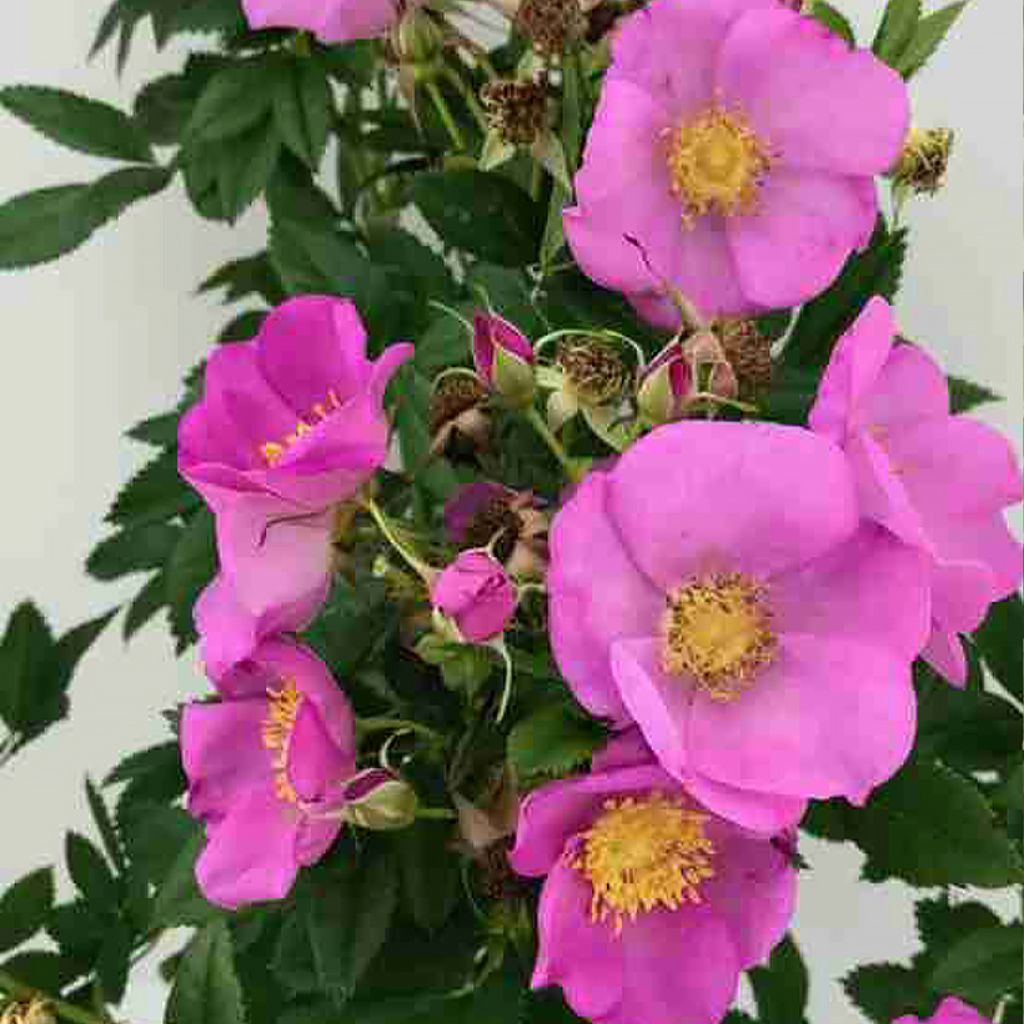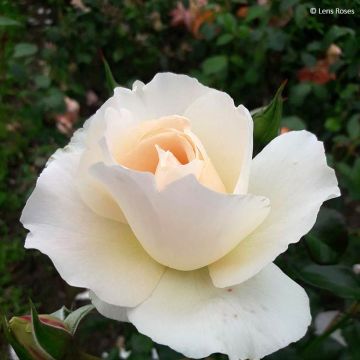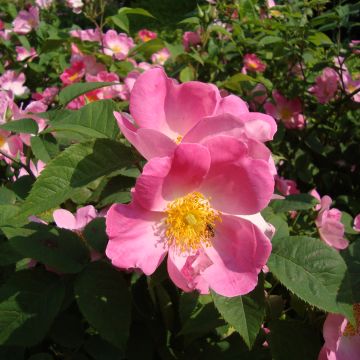

Rosier rugosa Jam-a-licious
Rosa rugosa x virginiana Jam-a-licious - Shrub Rose
Rosa rugosa x virginiana Jam-a-licious 'Spekjam'
Thanks to the people (for order preparation and shipping), the rose bush I received looks healthy. Planted near the 'Maria Mathilda' variety, I am now patiently waiting for it to take root... (or not?)
Thierry, 21/10/2023
This item cannot be shipped to the selected country
Delivery charge from €5.90
Delivery to Corse prohibited
More information
Schedule delivery date,
and select date in basket
This plant carries a 24 months recovery warranty
More information
We guarantee the quality of our plants for a full growing cycle, and will replace at our expense any plant that fails to recover under normal climatic and planting conditions.
From €5.90 for pickup delivery and €6.90 for home delivery
Express home delivery from €8.90.
Delivery to Corse prohibited: UE law prohibits the import of this plant from mainland France to Corse as part of the fight against Xylella fastidiosa. Please accept our sincere apologies.
More information
Does this plant fit my garden?
Set up your Plantfit profile →
Description
The Jam-a-licious Rosebush is a highly decorative shrub from spring to autumn, compact and very useful to the small fauna that frequents our gardens. This offspring of the rugosa rosebush and the Virginia rosebush combines the abundant fruiting of the former with the sumptuous autumn colours of the latter. Bushy, not very tall, and with few prickles, it produces many beautiful, nectar-bearing,pink flowers, and then scarlet fruits, which are decorative and edible and sought after by birds. This very hardy rosebush enjoys the sun, in a humus-rich, fertile soil that doesn't dry out too much in summer.
Rosa x rugosa Jam-a-licious was recently selected in the Netherlands. It forms a small, densely branched shrub, with an upright habit, reaching about 1.20 m (4ft) in height and 80 cm (32in) in width. The branches of this rosebush have only a few prickles. The deciduous foliage is abundant and resistant to diseases, composed of leaflets with serrated edges in a vivid green colour. In autumn, it takes on golden, orange, burgundy, and violet tones before falling. Its beautiful single flowers bloom in an intense pink colour, then fade slightly in the sun. At full bloom, they reveal a beautiful yellow stamens that attract pollinators. The abundant flowering takes place in May-June. After pollination, rounded, slightly flattened, fleshy fruits form, turning scarlet red when ripe. Persisting on the shrub for a long time, they enhance its charm at the end of the season. These edible fruits can also be used to make jams or jellies.
Rose Jam-a-licious, very hardy and low maintenance, is essential in a garden that makes room for nature, even when space is limited. Full of charm and resources, it brings life to the garden or patio for a good part of the year. It will find its place in a small hedge or in a shrub bed. To accompany it, consider, for example, groundcover roses such as Bee's Paradise Pink or Rosanatura Rosea. It can also be associated with a dwarf buddleia Nanho Purple, graceful and undemanding, with Euonymus alatus Compactus, magnificent in autumn, or even with Nandina Obsessed Seika.
Report an error about the product description
Plant habit
Flowering
Foliage
Botanical data
Rosa
rugosa x virginiana
Jam-a-licious 'Spekjam'
Rosaceae
Cultivar or hybrid
Other Roses A to Z
Planting and care
The Jam-a-licious rose is very resistant to harsh winters, but it doesn't tolerate heatwaves and excessively dry climates well. This variety is resistant to rose diseases. It adapts to any well-prepared soil, enriched with compost, that doesn't dry out too much in spring and summer. However, avoid limestone soils. Plant it in a sunny or partially shaded location. To maintain a bushy habit, pruning is simple: after winter, every 2 years, remove the oldest branches (2-3 years old). Very hardy, this rose can withstand temperatures as low as -25°C. It may be useful to remove dead wood in winter. If necessary, in spring, after the risk of frost has passed, a light pruning can be done.
To plant your rose, whether in a pot or in the ground, work the soil to a depth of 30 cm (12in), breaking up the soil well and adding a bottom dressing such as dried blood or dehydrated horn bonemeal. Position your plant, removed from its pot, covering the top of the root ball with 3 cm (1in) of soil, backfill and water thoroughly to remove air pockets. In dry weather, regular watering is necessary for a few weeks to encourage root establishment. Mulch in summer to conserve water. Also, remember to provide your rose with special rose fertiliser to stimulate flowering.
Planting period
Intended location
Care
-
, onOrder confirmed
Reply from on Promesse de fleurs
Haven't found what you were looking for?
Hardiness is the lowest winter temperature a plant can endure without suffering serious damage or even dying. However, hardiness is affected by location (a sheltered area, such as a patio), protection (winter cover) and soil type (hardiness is improved by well-drained soil).

Photo Sharing Terms & Conditions
In order to encourage gardeners to interact and share their experiences, Promesse de fleurs offers various media enabling content to be uploaded onto its Site - in particular via the ‘Photo sharing’ module.
The User agrees to refrain from:
- Posting any content that is illegal, prejudicial, insulting, racist, inciteful to hatred, revisionist, contrary to public decency, that infringes on privacy or on the privacy rights of third parties, in particular the publicity rights of persons and goods, intellectual property rights, or the right to privacy.
- Submitting content on behalf of a third party;
- Impersonate the identity of a third party and/or publish any personal information about a third party;
In general, the User undertakes to refrain from any unethical behaviour.
All Content (in particular text, comments, files, images, photos, videos, creative works, etc.), which may be subject to property or intellectual property rights, image or other private rights, shall remain the property of the User, subject to the limited rights granted by the terms of the licence granted by Promesse de fleurs as stated below. Users are at liberty to publish or not to publish such Content on the Site, notably via the ‘Photo Sharing’ facility, and accept that this Content shall be made public and freely accessible, notably on the Internet.
Users further acknowledge, undertake to have ,and guarantee that they hold all necessary rights and permissions to publish such material on the Site, in particular with regard to the legislation in force pertaining to any privacy, property, intellectual property, image, or contractual rights, or rights of any other nature. By publishing such Content on the Site, Users acknowledge accepting full liability as publishers of the Content within the meaning of the law, and grant Promesse de fleurs, free of charge, an inclusive, worldwide licence for the said Content for the entire duration of its publication, including all reproduction, representation, up/downloading, displaying, performing, transmission, and storage rights.
Users also grant permission for their name to be linked to the Content and accept that this link may not always be made available.
By engaging in posting material, Users consent to their Content becoming automatically accessible on the Internet, in particular on other sites and/or blogs and/or web pages of the Promesse de fleurs site, including in particular social pages and the Promesse de fleurs catalogue.
Users may secure the removal of entrusted content free of charge by issuing a simple request via our contact form.
The flowering period indicated on our website applies to countries and regions located in USDA zone 8 (France, the United Kingdom, Ireland, the Netherlands, etc.)
It will vary according to where you live:
- In zones 9 to 10 (Italy, Spain, Greece, etc.), flowering will occur about 2 to 4 weeks earlier.
- In zones 6 to 7 (Germany, Poland, Slovenia, and lower mountainous regions), flowering will be delayed by 2 to 3 weeks.
- In zone 5 (Central Europe, Scandinavia), blooming will be delayed by 3 to 5 weeks.
In temperate climates, pruning of spring-flowering shrubs (forsythia, spireas, etc.) should be done just after flowering.
Pruning of summer-flowering shrubs (Indian Lilac, Perovskia, etc.) can be done in winter or spring.
In cold regions as well as with frost-sensitive plants, avoid pruning too early when severe frosts may still occur.
The planting period indicated on our website applies to countries and regions located in USDA zone 8 (France, United Kingdom, Ireland, Netherlands).
It will vary according to where you live:
- In Mediterranean zones (Marseille, Madrid, Milan, etc.), autumn and winter are the best planting periods.
- In continental zones (Strasbourg, Munich, Vienna, etc.), delay planting by 2 to 3 weeks in spring and bring it forward by 2 to 4 weeks in autumn.
- In mountainous regions (the Alps, Pyrenees, Carpathians, etc.), it is best to plant in late spring (May-June) or late summer (August-September).
The harvesting period indicated on our website applies to countries and regions in USDA zone 8 (France, England, Ireland, the Netherlands).
In colder areas (Scandinavia, Poland, Austria...) fruit and vegetable harvests are likely to be delayed by 3-4 weeks.
In warmer areas (Italy, Spain, Greece, etc.), harvesting will probably take place earlier, depending on weather conditions.
The sowing periods indicated on our website apply to countries and regions within USDA Zone 8 (France, UK, Ireland, Netherlands).
In colder areas (Scandinavia, Poland, Austria...), delay any outdoor sowing by 3-4 weeks, or sow under glass.
In warmer climes (Italy, Spain, Greece, etc.), bring outdoor sowing forward by a few weeks.












































